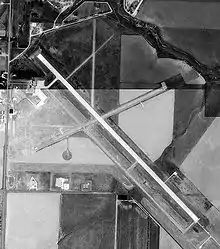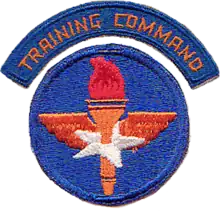Goodland Municipal Airport
Goodland Municipal Airport (IATA: GLD, ICAO: KGLD, FAA LID: GLD) (Renner Field) is two miles north of Goodland, in Sherman County, Kansas.[1]
Goodland Municipal Airport Renner Field | |||||||||||||||||||
|---|---|---|---|---|---|---|---|---|---|---|---|---|---|---|---|---|---|---|---|
 USGS image, 28 August 1991 | |||||||||||||||||||
| Summary | |||||||||||||||||||
| Airport type | Public | ||||||||||||||||||
| Owner | City of Goodland | ||||||||||||||||||
| Serves | Goodland, Kansas | ||||||||||||||||||
| Elevation AMSL | 3,656 ft / 1,114 m | ||||||||||||||||||
| Coordinates | 39°22′14″N 101°41′56″W | ||||||||||||||||||
| Runways | |||||||||||||||||||
| |||||||||||||||||||
| Statistics (2007) | |||||||||||||||||||
| |||||||||||||||||||
Facilities
The airport covers 372 acres (151 ha) at an elevation of 3,656 feet (1,114 m). It has three runways: 12/30 is 5,499 by 100 feet (1,676 x 30 m) concrete; 5/23 is 3,501 by 75 feet (1,067 x 23 m) asphalt; 17/35 is 1,800 by 40 feet (549 x 12 m) turf.[1]
In the year ending July 16, 2007 the airport had 43,000 aircraft operations, average 117 per day: 98% general aviation, 1% air taxi and 1% military. 22 aircraft were then based at the airport: 77% single-engine and 23% multi-engine.[1]
History
Provided contract glider training to the United States Army Air Forces, 1942-1943. Training provided by William A. Ong under AAFTC 22d Glider Training Detachment. Used primarily C-47 Skytrains and Waco CG-4 unpowered Gliders. Training began on 8 June 1942. The mission was to train glider pilot students in proficiency in operation of gliders in various types of towed and soaring flight, both day and night, and in servicing of gliders in the field.
During wartime the airport had four compacted soil runways; aligned N/S; NE/SW; E/W and NW/SE, all about 2,800' long with NE/SW 3,600' long. Former NW/SE runway now paved and used as main, others still visible in aerial photography. Training ended on 29 August 1943 due to shortage of equipment. Glider training mission was taken over by I Troop Carrier Command, and the airport was used as an axillary airfield until the end of the war. Returned to civil control in September 1945.
Historical Airline Service
Goodland first received scheduled airline service in the early 1930's by United States Airways which flew a Metal Aircraft Flamingo on an airmail route between Denver and Kansas City, stopping at Goodland, Salina, and Topeka, Kansas. This route was discontinued about 1933 and airline service didn't return to Goodland until 1961 when Central Airlines began service to Denver, Kansas City, and Wichita on Douglas DC-3s. The flights to Kansas City and Wichita made stops in other Kansas cities. In 1967 Central merged with the original Frontier Airlines (1950-1986) which continued service to Goodland with Convair 580s. Frontier ended service in 1976-77; Air Midwest began flying Fairchild Swearingen Metroliners on the same routes. In early 1988 Air Midwest to Goodland began code-sharing with Eastern Airlines, operating as Eastern Express. By late 1988 the agreement with Eastern had ended and Air Midwest began a new code-share agreement with Braniff (1983-1990) operating as Braniff Express. This agreement ended the following year when Braniff shut down. Air Midwest then reverted to operating under their own brand until early 1991 when another code-share agreement was set up with US Airways to operate as US Airways Express, with flights to Kansas City and Denver. Air Midwest ended service on April 15, 1992, and Mesa Airlines began service operating as United Express for United Airlines. This service was to Denver on Beechcraft 1900Ds. In 1998 the United Express flights to Denver were changed to Great Lakes Airlines Beechcraft 1900Ds. Great Lakes flights ended in early 2000; Goodland has not had airline service since.[2][3][4]
References
- FAA Airport Form 5010 for GLD PDF, effective 2009-07-02.
- Braniff - September 1, 1989 Timetable, Departed Flights, Retrieved 2013-05-01
- Air Midwest - February 15, 1986 System Timetable, Departed Flights, Retrieved 2013-05-01
- Multiple editions of the Official Airline Guide and airline timetables from each carrier that served Goodland
| Wikimedia Commons has media related to Renner Field (Airfield). |
Other sources
 This article incorporates public domain material from the Air Force Historical Research Agency website http://www.afhra.af.mil/.
This article incorporates public domain material from the Air Force Historical Research Agency website http://www.afhra.af.mil/.- Shaw, Frederick J. (2004), Locating Air Force Base Sites History’s Legacy, Air Force History and Museums Program, United States Air Force, Washington DC, 2004.
- Manning, Thomas A. (2005), History of Air Education and Training Command, 1942-2002. Office of History and Research, Headquarters, AETC, Randolph AFB, Texas ASIN: B000NYX3PC
External links
- Aerial photo as of 28 August 1991 from USGS The National Map
- FAA Airport Diagram (PDF), effective January 28, 2021
- FAA Terminal Procedures for GLD, effective January 28, 2021
- Resources for this airport:
- FAA airport information for GLD
- AirNav airport information for GLD
- FlightAware airport information and live flight tracker
- SkyVector aeronautical chart for GLD

